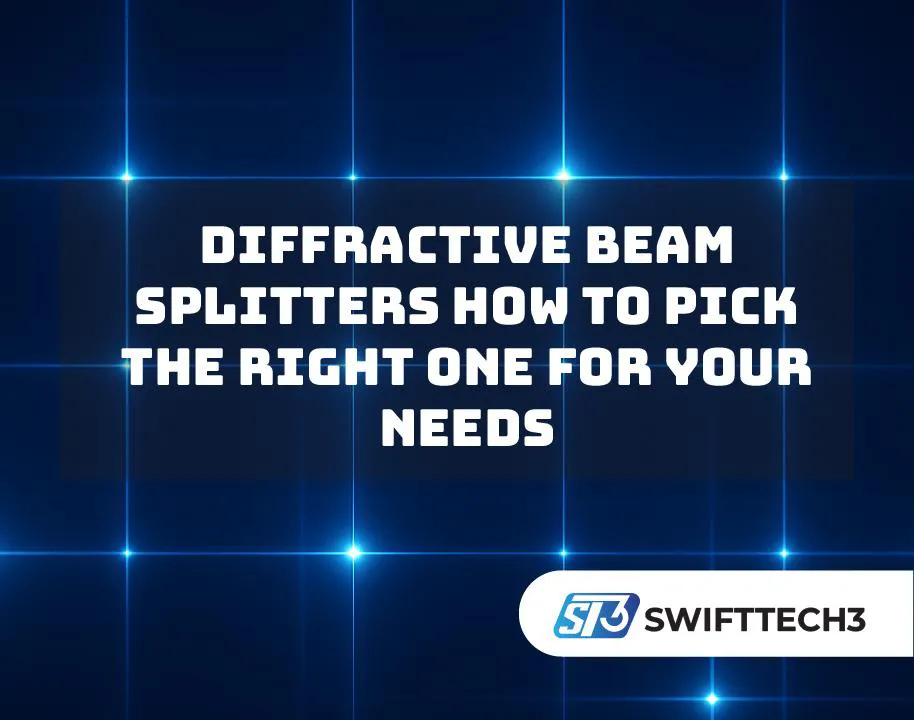Diffractive Beam Splitters
If you’re looking up diffractive beam splitters, you probably want more than just “split a beam.”
- You want precision.
- You want reliability.
- You need uniform output.
- You want something that lasts.
These devices take a single input beam and divide it into multiple output beams (beamlets). The goal is: each output should match the original in terms of beam quality, divergence, and often polarization, except, of course, the intensity per beam is lower. For many applications, that’s enough. But for serious systems, several details decide success or failure.
What to Expect & What to Demand
Here’s what people who knows this field well always care about. These are non-negotiables, things that top ranked specs always list, and things you should look for.
Number of beamlets and array layout
Do you need a row (1×N), a grid (2D matrix), or something custom (hexagonal, random dots)? The layout effect spot spacing, uniformity, and how easy it is to focus those spots.
Angle separation & working distance
How far apart you want the output beams? How far away from the splitter will the output spots lies? These determine how big the optic after the splitter need to be. When specs list the separation angle and working distance, it helps you plan lens setup correct.
Zero-order suppression
One frequent problem is the “zero-order” beam — the undiffracted light that continue straight through. If it’s strong, it eat into power, add background signal, can hurt contrast. Good splitter tell you what the zero-order percentage is.
Bandwidth and wavelength tolerance
Most beam splitters are made for a specific wavelength. Deviation of ±1-2% are often tolerated without disaster. But if your source shift more, output angles shift and efficiency drop. Some of the newer work (example on metasurface-enable design) show more broadband capability.
Fabrication quality and uniformity
Tiny fabrication error, groove depth, period uniformity, surface smooth all matter. If one spot is slight off, your whole pattern look messy. Good splitter reports uniformity variation, often in low single digit percent.
Power handling and thermal stability
If your beam carry high power, that power must not degrade the splitter. Material should handle heat, coating should resist damage. Some design handle pulse lasers, others only continuous wave. Knowing limit is essential.
Optical loss and efficiency
How much of your input power turn into useful beams? What fraction is lost (scatter, absorbed, or in undesired orders)? The higher the overall diffraction efficiency, the better your throughput. Many good splitter reach high efficiencies by using advance phase profile (binary, multilevel, or even metasurface designs).
Applications Help Shape the Specs
What you use a diffractive beam splitter for change which specs matter most to you.
In industrial laser machining or cutting, you want many beamlets to increase speed. Uniformity and efficiency matter more then tiny angle precision.
In medical/aesthetic work (fractional lasers, skin treatments), you want clean, well define spots so treatments are safe and repeatable. Zero-order suppression and spot shape is crucial here.
For 3D sensing, LiDAR, or structured light scanner, you care about angle separation, uniform intensity, and low background noise.
In quantum optic, science experiment, or metrology — you need very low distortion, minimal unwanted orders, and excellent stability over time and temperature.
What New Research Adds
Some recent advance are pushing what’s possible:
- Metasurface based beam splitters that integrate function like polarization control and zero-order suppression in one flat element. This open up design that were not possible before.
- Designs using inverse methods (optimization algorithm) to generate wide-angle splitter with many beamlets, while keeping uniformity error fairly small.
- Three port splitters (splitting into +1, 0, and -1 orders) with balance power distribution, especially under normal incidence, giving useful design for imaging or interferometric setup.
These innovation mean newer splitter can do more with less — less waste, less background, more usable output.
How to Decide for Your Project
Here are step you can follow:
- List your require beam count, layout, working distance, and wavelength. Be very specific.
- Compare spec sheet from several suppliers. Match beam count, output pattern, zero-order limit, uniformity percent.
- If possible, test sample splitter in your application, especially under real environmental condition (temperature, vibrations, power).
- Be mindful of system integration: lens quality, alignment tolerance, space constraint. Even a good splitter fail if the mounting is bad.
Final Thoughts
Diffractive beam splitters are powerfull tools. They let you multiply your beam output without copying mechanical mirrors. But they delicate in how they must be design and used.
The right splitter is one that match your layout, your beam power, your wavelength, and your real world constraint. If you pick careful, the device will serve you well for year. If not, it will cause headache.
Final Thoughts
Diffractive beam splitters are powerful tools. They let you multiply your beam output without copying mechanical mirrors. But they’re delicate in how they must be designed and used.
The right splitter is one that matches your layout, your beam power, your wavelength, and your real-world constraints. If you pick carefully, the device will serve you well for years. If not, it will cause headaches.

FAQs.
You won’t feel alone. Many people see that. It usually means the splitter’s uniformity spec was optimistic, or input beam wasn’t aligned well. Testing with a sample early will show this.
That depends. If you need high efficiency (low loss) or many outputs, you’ll likely need more complex profiles. If your application tolerates some loss and you want cost‐oriented, binary or simpler gratings may still serve.
This worry is valid. Power and heat stress build up quietly. If materials or coatings aren’t up to spec, you’ll see degradation: patterns blur, efficiency drops. Choosing one with solid thermal specs, tested power handling, and good material makes a big difference.


